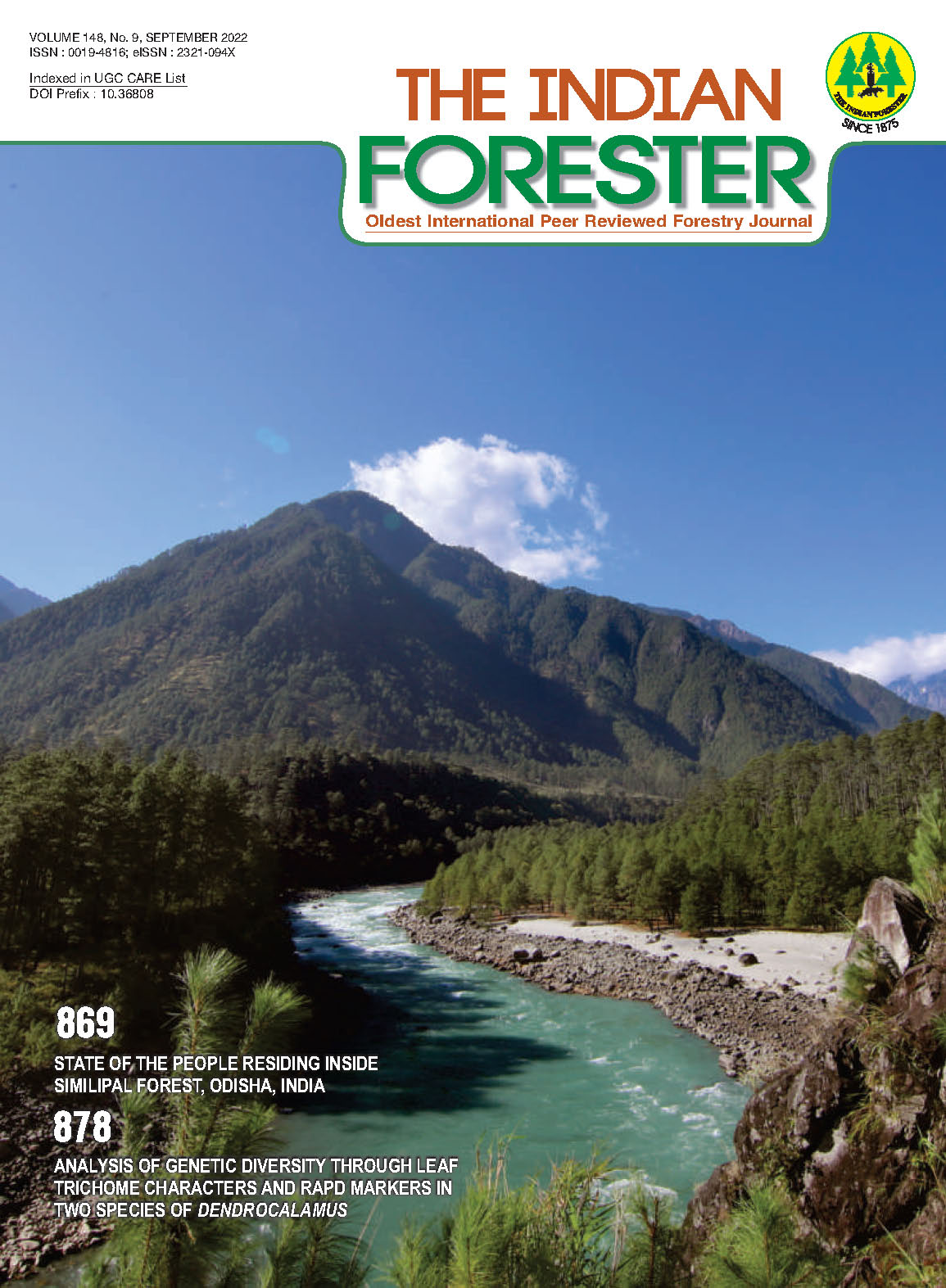Understanding Psammophory in Raphanus sativus and Lagenaria siceraria: An Approach to Reduce Herbivory
DOI:
https://doi.org/10.36808/if/2022/v148i9/162825Keywords:
Psammophory, Herbivory, Sand, Kaolin, TrichomesAbstract
Sand entrapment on plant surfaces, termed psammophory is a widely knowntrait of the plants having significance in reducing herbivory and regarded as
one of the potential plants defense phenomena. Trichomes protruding from
the surface of leaves and stems defend plants from many herbivores. These
trichomes of plants often entrap sand on their surfaces or release some
exudates on which sand can get adhered, this phenomenon of carrying sand
on their surfaces is called psammophory. Sand and soil are naturally nonnutritive and most of the herbivores find them difficult to process. The
presence of these substances (soil, sand) increases the plant defense and
reduce herbivory. There is lack of studies for investigating the impact of
psammophory on economic plants including vegetables. The current study
attempts to understand the benefit of the psammophoric properties of soil
and sand in reducing the attacks of herbivores on radish (Raphanus sativus)
and bottle gourd (Lagenaria siceraria). Both of these species suffer a heavy
loss in their yield due to cabbage borer (Hellula undalis Fabr.) and western
striped cucumber beetle (Acalymma vittata), respectively. The current study
examined whether presence of sand on these plant surfaces physically
protected them from herbivores.
References
Cyr H., Face M. (1993). Magnitude and patterns of herbivory in aquatic and terrestrial ecosystems. Nature, 361: 148–150. https://doi.org/10.1038/361148a0
De Moraes C.M. and Mescher M.C. (2004). Biochemical crypsis in the avoidance of natural enemies by an insect herbivore. Proceedings of the National Academy of Sciences, 101(24): 8993-8997.
Farmer E.E. (2014). Leaf defence. Oxford University Press, Oxford.
Hochuli D.F. (1996). The ecology of plant/insect interactions: implications of digestive strategy for feeding by phytophagous insects. Oikos, 75: 133–141.
Hwang B.C. and Metcalfe D.B. (2021). Reviews and syntheses: Impacts of plant-silica-herbivore interactions on terrestrial biogeochemical cycling. Biogeosciences, 18(4): 1259-1268.
Johnson S.N., Hartley S.E., Ryalls J.M., Frew A. and Hall C.R. (2021). Targeted plant defense: silicon conserves hormonal defense signaling impacting chewing but not fluid-feeding herbivores. Ecology, 102(3): e03250.
Jürgens N. (1996). Psammophorous plants and other adaptations to desert ecosystems with high incidence of sandstorms. Feddes Repertorium, 107(5-6): 345-359.
Kvedaras O.L. and Keeping M.G. (2007). Silicon impedes stalk penetration by the borer Eldana saccharina in sugarcane. Entomologia Experimentalis et Applicata, 125(1): 103-110.
Legault G. (2007). Effect of kaolin on the striped cucumber beetle (Acalymma vittatum) and cucumber growth and development.
Lev-Yadun S. and Gould K.S. (2007). What do red and yellow autumn leaves signal? The Botanical Review, 73(4): 279-289.
Massey F.P. and Hartley S.E. (2006). Experimental demonstration of the anti-herbivore effects of silica in grasses: impacts on foliage digestibility and vole growth rates. Proceedings of the Royal Society B: Biological Sciences, 273(1599): 2299-2304.
Massey F.P., Ennos A.R. and Hartley S.E. (2006). Silica in grasses as a defence against insect herbivores: contrasting effects on folivores and a phloem feeder. Journal of Animal Ecology, 75(2): 595-603.
Massey F.P., Ennos A.R. and Hartley S.E. (2007). Herbivore specific induction of silica-based plant defences. Oecologia, 152(4): 677-683.
Nascimento P.T., Fadini M.A., Rocha M.S., Souza C.S., Barros B.A., Melo J.O. and Valicente F.H. (2021). Response of Trichogramma pretiosum females (Hymenoptera: Trichogrammatidae) to herbivore-induced Bt maize volatiles. Arthropod-Plant Interactions, 15(1): 107-125.
Nordlander G., H. Nordenhem and C. Hellqvist (2009). A flexible sand coating (Conniflex) for the protection of conifer seedlings against damage by the pine weevil Hylobius abietis. Agricultural and Forest Entomology, 11: 91–100.
Showler A.T. (2002). Effects of Kaolin-based particle film application on boll weevil (Coleoptera: Curculionidae) injury to cotton. Journal of Economic Entomology, 95: 754–762.
Showler A.T. (2003). Effects of Kaolin particle film on beet armyworm, Spodoptera exigua (Hubner) (Lepidoptera: Noctuidae), oviposition, larval feeding and development on cottton, Gossypium hirsutum L. Agriculture, Ecosystems and Environment, 95: 265–271.
Vicari M. and Bazely D.R. (1993). Do grasses fight back? The case for antiherbivore defences. Trends in ecology and evolution, 8(4): 137-141.
Downloads
Downloads
Published
How to Cite
Issue
Section
License
Unless otherwise stated, copyright or similar rights in all materials presented on the site, including graphical images, are owned by Indian Forester.





